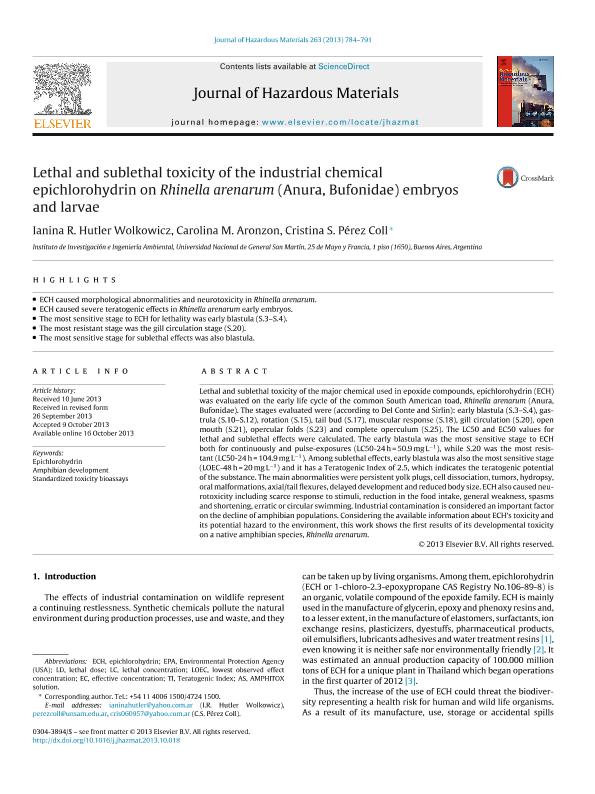Mostrar el registro sencillo del ítem
dc.contributor.author
Hutler Wolkowicz, Ianina Ruth

dc.contributor.author
Aronzon, Carolina Mariel

dc.contributor.author
Perez Coll, Cristina Silvia

dc.date.available
2017-11-15T14:55:38Z
dc.date.issued
2013-12
dc.identifier.citation
Hutler Wolkowicz, Ianina Ruth; Aronzon, Carolina Mariel; Perez Coll, Cristina Silvia; Lethal and sublethal toxicity of the industrial chemical epichlorohydrin on Rhinella arenarum (Anura, Bufonidae) embryos and larvae; Elsevier Science; Journal of Hazardous Materials; 263; 2; 12-2013; 784-791
dc.identifier.issn
0304-3894
dc.identifier.uri
http://hdl.handle.net/11336/28212
dc.description.abstract
Lethal and sublethal toxicity of the major chemical used in epoxide compounds, epichlorohydrin (ECH) was evaluated on the early life cycle of the common South American toad, Rhinella arenarum (Anura, Bufonidae). The stages evaluated were (according to Del Conte and Sirlin): early blastula (S.3–S.4), gastrula (S.10–S.12), rotation (S.15), tail bud (S.17), muscular response (S.18), gill circulation (S.20), open mouth (S.21), opercular folds (S.23) and complete operculum (S.25). The LC50 and EC50 values for lethal and sublethal effects were calculated. The early blastula was the most sensitive stage to ECH both for continuously and pulse-exposures (LC50-24 h = 50.9 mg L−1), while S.20 was the most resistant (LC50-24 h = 104.9 mg L−1). Among sublethal effects, early blastula was also the most sensitive stage (LOEC-48 h = 20 mg L−1) and it has a Teratogenic Index of 2.5, which indicates the teratogenic potential of the substance. The main abnormalities were persistent yolk plugs, cell dissociation, tumors, hydropsy, oral malformations, axial/tail flexures, delayed development and reduced body size. ECH also caused neurotoxicity including scarce response to stimuli, reduction in the food intake, general weakness, spasms and shortening, erratic or circular swimming. Industrial contamination is considered an important factor on the decline of amphibian populations. Considering the available information about ECH's toxicity and its potential hazard to the environment, this work shows the first results of its developmental toxicity on a native amphibian species, Rhinella arenarum.
dc.format
application/pdf
dc.language.iso
eng
dc.publisher
Elsevier Science

dc.rights
info:eu-repo/semantics/openAccess
dc.rights.uri
https://creativecommons.org/licenses/by-nc-nd/2.5/ar/
dc.subject
Epiclohidrina
dc.subject
Toxicidad
dc.subject
Desarrollo Embrilarval
dc.subject
Anfibios
dc.subject.classification
Meteorología y Ciencias Atmosféricas

dc.subject.classification
Ciencias de la Tierra y relacionadas con el Medio Ambiente

dc.subject.classification
CIENCIAS NATURALES Y EXACTAS

dc.title
Lethal and sublethal toxicity of the industrial chemical epichlorohydrin on Rhinella arenarum (Anura, Bufonidae) embryos and larvae
dc.type
info:eu-repo/semantics/article
dc.type
info:ar-repo/semantics/artículo
dc.type
info:eu-repo/semantics/publishedVersion
dc.date.updated
2017-11-15T13:49:05Z
dc.journal.volume
263
dc.journal.number
2
dc.journal.pagination
784-791
dc.journal.pais
Países Bajos

dc.journal.ciudad
Amsterdam
dc.description.fil
Fil: Hutler Wolkowicz, Ianina Ruth. Consejo Nacional de Investigaciones Científicas y Técnicas; Argentina. Universidad Nacional de San Martín. Instituto de Investigación e Ingeniería Ambiental; Argentina
dc.description.fil
Fil: Aronzon, Carolina Mariel. Consejo Nacional de Investigaciones Científicas y Técnicas; Argentina. Universidad Nacional de San Martín. Instituto de Investigación e Ingeniería Ambiental; Argentina
dc.description.fil
Fil: Perez Coll, Cristina Silvia. Consejo Nacional de Investigaciones Científicas y Técnicas; Argentina. Universidad Nacional de San Martín. Instituto de Investigación e Ingeniería Ambiental; Argentina
dc.journal.title
Journal of Hazardous Materials

dc.relation.alternativeid
info:eu-repo/semantics/altIdentifier/doi/http://dx.doi.org/10.1016/j.jhazmat.2013.10.018
dc.relation.alternativeid
info:eu-repo/semantics/altIdentifier/url/http://www.sciencedirect.com/science/article/pii/S0304389413007462
Archivos asociados
